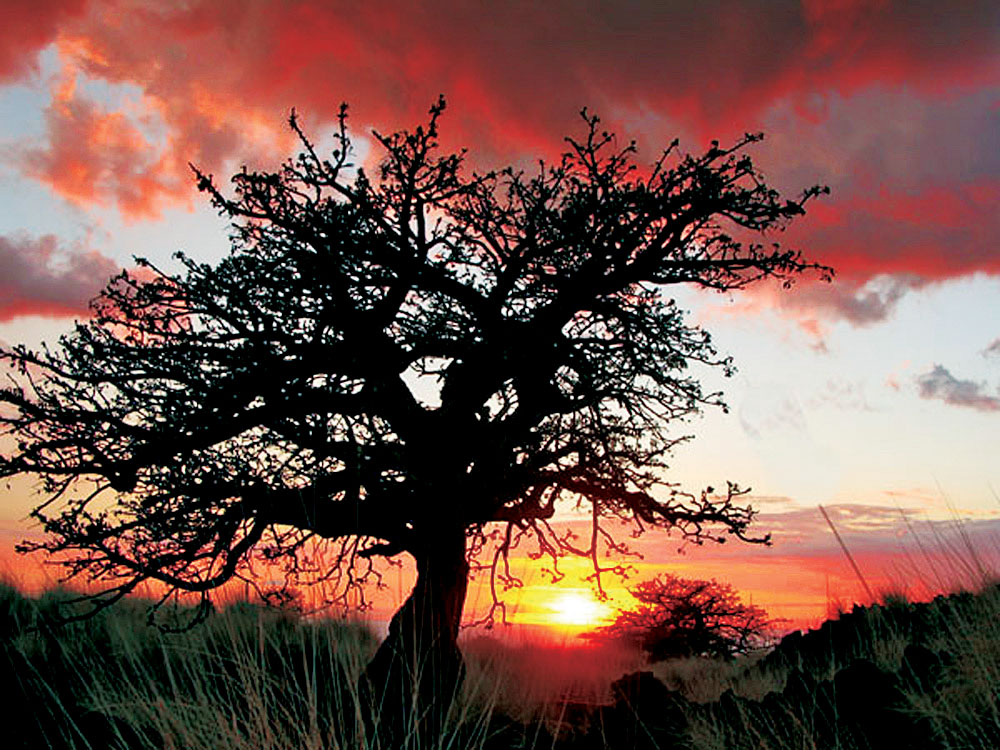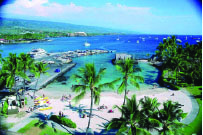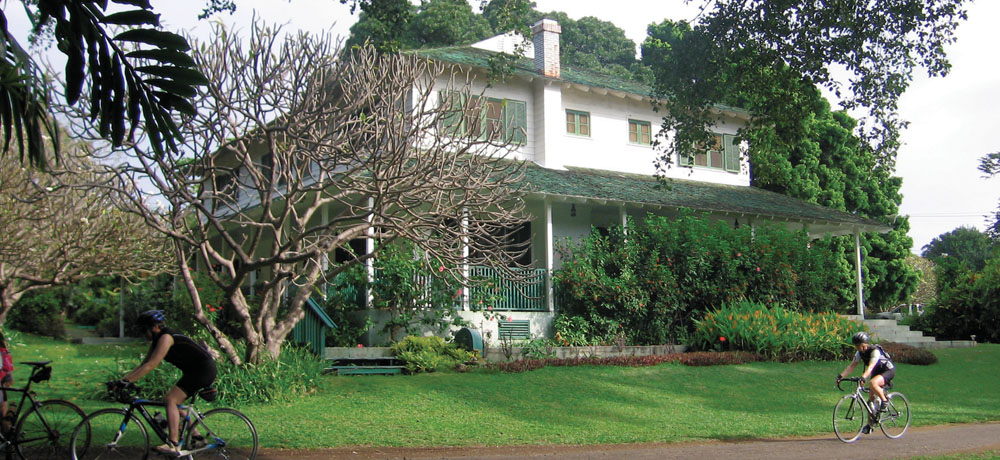
Plantation Era Is Gone, and Pahala Lives On: Historic Preservationist Julia Neal Uses Hammer and Wood to Pull the Community Together

By Ann C. Peterson
When the Pahala Sugar Mill closed in 1996, after 135 years as the town’s major employer, the village of Pahala in the Big Island’s southern district of Ka‘u went quiet. Some folks moved, but many local residents stepped up and bought houses, including larger homes on manager’s row. It was a unique situation, without a rush of outside investors scooping up houses to gentrify the town. In the midst of this change, one of the houses left without a steward was the biggest—the huge, plantation manager’s house.
Julia Neal and Michael Worthington lived just across the street, where they could see the shutters flapping and paint peeling. After the plantation manager left, the stately house, built in the early 1900s with solid ‘ohi‘a floors, had briefly served as a drug and alcohol treatment center and now was vacant again.

Julia had moved to Kona from Kaua‘i just before Hurricane Iniki hit in 1992, after a career at The Garden Island newspaper, where she served as its editor. She moved to Hawai‘i Island in part to launch the visitor guide Big Island Gold, writing, photographing and setting up its accounts and circulation. She also became the marketer for the Captain Cook and Adventure V cruises. While living in Kona, she took on publishing and editing the Mahalo Air inflight magazine. With the first direct Japan Airlines flight to Kona, she started the Japanese visitor publication International Guide to the Big Island, now in its 14th year.
Always busy, she sought to get away to a peaceful place and found Pahala, where she met furniture builder Michael Worthington, who also traveled to the village to retreat from his own busy life in Kona at Worthington Woodworks. The couple began driving to Pahala together—ultimately buying their first home in 1998.
Julia has an inherent interest in preserving both Hawai‘i’s rich and diverse culture and its historical buildings. While living on Kaua‘i, she helped collect oral histories for the National Endowment for the Humanities and helped to get a number of sites listed in the State and National Registries of Historic Places. In The Garden Island newspaper she ran a weekly column on historic buildings. These experiences with plantation history prepared her well for her life in Pahala.
Looking at the old manager’s house, Julia worried that it could “become a symbol of the demise of the town. The alternative? Community support could make it a beacon for Pahala’s recovery,” she says. “If it were let go, this historic building could have been condemned and torn down to create house lots,” she adds.
Julia went to C. Brewer and asked to lease the house at a very low rate and promised to help restore it. The owners agreed and restoration began while community groups, from churches to seniors to local wedding parties, started using it. All along, Julia thought her stewardship was temporary. She would never be able to afford to purchase the house to keep it for the community. Brewer started showing it for sale and she thought she had accomplished at least one goal—saving it from ruin.
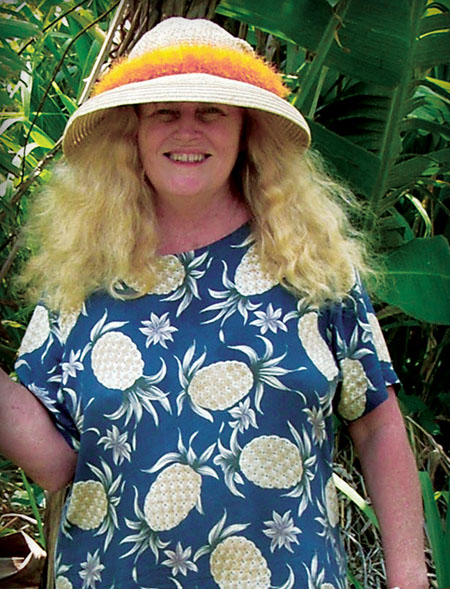
Then an amazingly serendipitous event occurred. A great aunt died, and unbeknownst to Julia, left her a small inheritance. The amount was within $1,000 of the sum needed to purchase the property fee simple, and quickly the historic home became Julia’s to maintain and keep open for the village and visitors.
She established it as the Pahala Plantation House, a bed and breakfast inn, and since then many have walked through its doors and felt as though they were stepping back 80 years, and walking into the home of an ancestor. Unpretentious (a word that also describes its owner), it is expertly furnished for the era, with beautiful wood floors, period artwork and china cases full of chochkes—each one an antique with its own unique story. It’s like a living history museum where groups can stay overnight and you can touch anything.
As Julia and Michael restored the house, they involved community members and invited everyone in. “I’ll never forget a man who brought his mother in a wheelchair for a tour”, says Julia. “She was 90 years old, lived in Pahala her whole life, and had never been inside the house. Now I’d be surprised if you could find anyone in Pahala who hasn’t been there. The house is used by neighbors for weddings, graduations, baby lu‘au, community meetings and when they have family visiting,” explains Julia.
Perhaps Pahala was saved from rampant tourist development because of its remoteness and its lack of the sandy beaches, calm snorkeling waters and waterfalls that usually attract the mainland buyers, Julia says. In this isolation, former plantation workers have had time to adjust to a new economy. The impact of the shutdown of sugar mills was great, but they were able to keep their families intact and help direct the future of their own community.
With the perfect growing conditions and harbors at Na‘alehu and Honu‘apo, Ka‘u provided the ideal conditions for Hawai‘i’s sugar industry. So vast was its hold over the islands that at one time, one of every 12 persons employed in Hawai‘i worked in the industry. In Pahala the hold was even more evident, with virtually everyone having ties to what was called “King Sugar.”
“We have the kind of village that everyone wants to live in,” says Julia. “As large as the entire island of O‘ahu, Ka‘u is big land and small community. Everybody knows everybody and everybody steps forward and volunteers. Pahala is safe, walkable and away from the highway. It has all the amenities of a regional center; a K-12 school—the center of the village both physically and energetically—a hospital, swimming pool, bank, post office, stores, restaurant and lots of open space.
Punalu‘u Black Sand Beach and Wood Valley are six minutes away and the village is surrounded by ocean, forest, mountains, ranches, macadamia orchards, coffee and vegetable farms. The list goes on and on,” she says with pride.
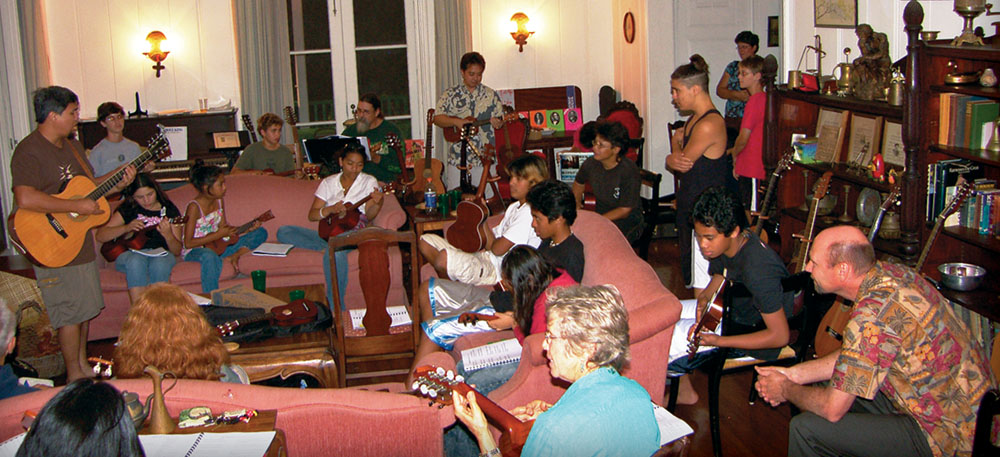
Julia heard that a number of old teachers’ cottages located on the school grounds were going to be demolished and began looking for ways to save them, too. “Michael and I didn’t have any savings or backing, so we used our credit cards to buy land and move the houses, then leveraged the renovations into a mortgage,” she explains. They were able to save four of the cutest bungalows, each a duplex, and place them naturally on rolling hills near the center of the village. They are now part of their business, Pahala Plantation Cottages.
For those who have never been to Pahala, it’s easy to drive by because this is one town on the island that does not have any commercial activity on the highway. To get there, you turn mauka off Highway 11 between the 51 and 52 mile marker. There are two roads into Pahala from the highway. I like taking Maile Street. It’s arrow straight, on an upward slope and bordered by grass right to the edge of the pavement and Norfolk Island pines over 50 feet tall on both sides for more than a half mile before the road turns—it’s a stunning piece of roadway. Once you turn, you first see the Old Pahala Clubhouse on your left. This building and the bungalow next to it were restored with community volunteers and funding from the Edmund C. Olson Trust; the Clubhouse proves to be a perfect venue for community functions and visiting group retreats.
Catty-corner to these buildings, on the other side of the peaceful and tree-lined, narrow roadway is another building that Julia and Michael restored. It is the old bank and now the home of a community radio venture led by local recording artist Demetrius Oliveira, of the band Ka‘u.
Just a little farther down on the mauka side at Maile and Pikake Streets is the recently restored Olson Trust Building, where Pahala Plantation Cottages reception, the new Ka`u Coffee Mill office, the Ka‘u Calendar newspaper, Hawai‘i Volcanoes National Park and Ka`u Main Street have their presence. On the makai side is the Plantation House. It is surrounded by trees and hard to see; plus, there are no signs letting you know—in gaudy 21st century fashion—that you have arrived.
That there are no signs is part of the beauty of Pahala. “There are vacation rentals here in Pahala, but none of them have signage. When visitors stay here, they are considered part of the community,” says Julia.
Their more recent save was once the Ka‘u Meat Market, renamed Ka‘u Market House, and is now a beautifully designed meeting house, with three bedrooms and space for a dozen or so people to meet around a long table or couch area.
Tourism is low-key in the village, and it is kept at a good, sustainable level, which helps Pahala draw some very sophisticated visitors. “The world comes here,” Julia says, and begins the litany. Steve Chapple, writer with National Geographic Traveler came here to write Pahala, Hawai‘i: The Last Aloha Region. “He comes back almost every year,” she says.
President Obama’s sister came for a wedding. Neil Abercrombie, in his bid for governor, campaigned at Pahala Plantation House in March.
Among many other interesting guests Julia has hosted are opera singers from New York, including the Julliard graduate and daughter-in-law of Ka‘u coffee farmer Lorie Obra, soprano Amy Shoremount-Obra. She brought in tenor Jon-Michael Ball and pianist Carol Wong to teach for a week at Ka‘u High School…and give a concert at the Plantation House. Chef Alan Wong visited Pahala Plantation House for a Ka‘u Coffee tasting and selected several boutique roasts from the local coffee farmers to French press and serve at his restaurants.
A film crew from Canadian television’s Mantracker series, known for its search and rescue, came to the village, stayed at the Pahala Market House, met with local ranchers and hired the local cowboys, providing a nice bump in the Pahala economy for a few weeks—the beauty of Ka‘u to be broadcast into 30 million homes this fall.
Pahala Plantation House is the site of annual music workshops led by Keoki Kahumoku, who brings in slack key and ‘ukulele masters to teach students, including the children of Ka‘u. At one music workshop with Daniel Ho, where students learn not only how to compose music but also how to negotiate in the music industry, a song about The Nature Conservancy’s Ka‘iholena in Ka‘u Forest Preserve was co-authored [see story about Bolo]. It is featured on an album nominated this year for a Grammy Award, and earnings from the recording go back to future music workshops at Plantation House. The late Uncle George Na‘ope also recorded an album there.

a class at Ka‘u High School.
Looking to the future, residents are studying how the village can be enriched by the National Park Service’s recent acquisition of 117,000 acres that span the lands above Pahala between Volcanoes National Park and Kahuku, near South Point. “We want to grow elegantly and keep the charm of this village and its great respect for the local culture,” says Julia. “There is an opportunity to liaison with the park in creating much-needed educational and employment opportunities, and in linking the development of the park and village.”
Another concern of the village is preserving the longest uninhabited shoreline in the state, the Ka‘u Coast. When Julia learned that coastal property between Pahala and Na‘alehu could be sold for development, she and the staff of her monthly publication, Ka‘u Calendar, funded and co-produced Saving Ka‘u’s Coast, with filmmaker Danny Miller. They handed out the film on the opening day of the State Legislature, went to Washington to give it to members of Congress and showed it to the County Council. A gripping documentary, it was featured at the annual Oceans Film Festival in Santa Barbara. Along with the leadership of Trust for Public Lands and community organizers like John Replogle, founder of Ka ‘Ohana O Honu‘apo, the film served as a valuable tool in helping the community to raise over $4 million to preserve Honu‘apo. In the last decade, more than 1,000 acres along the Ka‘u Coast have been transferred to public domain.
Julia is a big promoter of Ka‘u coffee. She took the Ka‘u Coffee Growers Cooperative’s southern brew to Washington DC, where it became the official coffee at an Obama inauguration gala at the historic Hay Adams Hotel next door to the White House. It’s clear that she loves pointing out that coffees from individual Ka‘u growers have become yearly award winners at the Specialty Coffee Association of America’s International Expo, beating out much bigger and more established plantations in Central and South America. “Most of Ka‘u’s coffee farms are five to seven acres,” and a number of these are run by displaced sugar workers who “gotta make it,” shares Julia. To help farmers, the Olson Trust is nearing completion of a coffee mill on Wood Valley Road.
Ka‘u coffee will be highlighted at the Ka‘u Coffee Festival at Pahala Community Center. This and other events are always reported in the Ka`u Calendar and online at www.kaucalendar.com, the monthly newspaper that pulls the vast community together by highlighting the “good news.” Julia–more cheerleader than editor – places a “microscopic focus” on the events in Ka‘u, celebrating and documenting life in the district, and she maintains an objective viewpoint.
Her next dream is the renovation of the old Japanese schoolhouse into the permanent Pahala Boys & Girls Club. While Julia dismisses the term “queen of serendipity,” a title sometimes given to her around Ka‘u to distinguish her from an organized and shrewd business person, she does admit to being “an open person who enjoys the qualities of this historic place – and wants to help.” She illustrates perfectly, “that good things happen when you are in a good place.” ❖
Email Ann Peterson at anncinzi@gmail.com.
